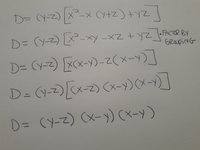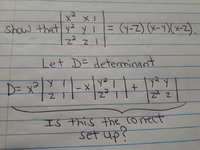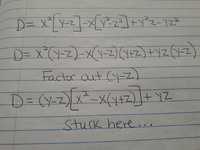You are using an out of date browser. It may not display this or other websites correctly.
You should upgrade or use an alternative browser.
You should upgrade or use an alternative browser.
Determinant Prove
- Thread starter harpazo
- Start date
D
Deleted member 4993
Guest
yes
harpazo
Full Member
- Joined
- Jan 31, 2013
- Messages
- 891
I will work this out on paper. If I get stuck, I will return here for further discussion.
harpazo
Full Member
- Joined
- Jan 31, 2013
- Messages
- 891
Dr.Peterson
Elite Member
- Joined
- Nov 12, 2017
- Messages
- 16,105
The yz at the end should be inside the brackets.
Then I'd expand inside; there will be four terms, so factoring by grouping might be a good idea.
Another way you could have done this is just to fully expand the determinant as a sum of products, and then do the same to the right-hand side of what you are to prove. If the results are equal, you're done.
But your way is good factoring practice!
Then I'd expand inside; there will be four terms, so factoring by grouping might be a good idea.
Another way you could have done this is just to fully expand the determinant as a sum of products, and then do the same to the right-hand side of what you are to prove. If the results are equal, you're done.
But your way is good factoring practice!
harpazo
Full Member
- Joined
- Jan 31, 2013
- Messages
- 891
The yz at the end should be inside the brackets.
Then I'd expand inside; there will be four terms, so factoring by grouping might be a good idea.
Another way you could have done this is just to fully expand the determinant as a sum of products, and then do the same to the right-hand side of what you are to prove. If the results are equal, you're done.
But your way is good factoring practice!
Thank you. I will try this tomorrow morning after the museum. Going to work now.
harpazo
Full Member
- Joined
- Jan 31, 2013
- Messages
- 891
The yz at the end should be inside the brackets.
Then I'd expand inside; there will be four terms, so factoring by grouping might be a good idea.
Another way you could have done this is just to fully expand the determinant as a sum of products, and then do the same to the right-hand side of what you are to prove. If the results are equal, you're done.
But your way is good factoring practice!
I really tried to complete this prove on paper but to no avail. Can you please show me the complete prove?
pka
Elite Member
- Joined
- Jan 29, 2005
- Messages
- 11,971
If I were to do this, I would expand along the third column.I really tried to complete this prove on paper but to no avail. Can you please show me the complete prove?
Then the LHS becomes \(\displaystyle zy^2-xy^2+xz^2-yz^2+yx^2-zx^2\)
Expand the RHS: \(\displaystyle x^2y-xy^2-xyz+y^2z-x^2z+xyz+xz^2-yz^2\)
By inserting \(\displaystyle \pm xyz\) into the LHS & rearranging you should see the equality.
harpazo
Full Member
- Joined
- Jan 31, 2013
- Messages
- 891
If I were to do this, I would expand along the third column.
Then the LHS becomes \(\displaystyle zy^2-xy^2+xz^2-yz^2+yx^2-zx^2\)
Expand the RHS: \(\displaystyle x^2y-xy^2-xyz+y^2z-x^2z+xyz+xz^2-yz^2\)
By inserting \(\displaystyle \pm xyz\) into the LHS & rearranging you should see the equality.
I'll try it again.
LCKurtz
Full Member
- Joined
- May 3, 2019
- Messages
- 475
If you know a bit about determinant properties, there is a nice way using them. Consider the determinant:
[MATH] \large P(x) = \left | \begin{array}{ccc} x^2 & x & 1\\ a^2 & a & 1\\ b^2 & b & 1 \end{array} \right | [/MATH]
where I have used [MATH]a[/MATH] and [MATH]b[/MATH] instead of [MATH]y[/MATH] and [MATH]z[/MATH] and called it [MATH]P(x)[/MATH]. The first two entries in column 1 are [MATH]x^2[/MATH] and [MATH]a^2[/MATH] but they are displaying incorrectly on my screen. I don't know why and maybe one of the mods can correct it. Anyway, expanding by the first row we know [MATH]P(x)[/MATH] is a polynomial of degree [MATH]2[/MATH] with leading coefficient the cofactor of [MATH]x^2[/MATH]. Also note that [MATH]P(a) = P(b) = 0[/MATH]. Now use the factor theorem on [MATH]P(x)[/MATH].
[MATH] \large P(x) = \left | \begin{array}{ccc} x^2 & x & 1\\ a^2 & a & 1\\ b^2 & b & 1 \end{array} \right | [/MATH]
where I have used [MATH]a[/MATH] and [MATH]b[/MATH] instead of [MATH]y[/MATH] and [MATH]z[/MATH] and called it [MATH]P(x)[/MATH]. The first two entries in column 1 are [MATH]x^2[/MATH] and [MATH]a^2[/MATH] but they are displaying incorrectly on my screen. I don't know why and maybe one of the mods can correct it. Anyway, expanding by the first row we know [MATH]P(x)[/MATH] is a polynomial of degree [MATH]2[/MATH] with leading coefficient the cofactor of [MATH]x^2[/MATH]. Also note that [MATH]P(a) = P(b) = 0[/MATH]. Now use the factor theorem on [MATH]P(x)[/MATH].
harpazo
Full Member
- Joined
- Jan 31, 2013
- Messages
- 891
The yz at the end should be inside the brackets.
Then I'd expand inside; there will be four terms, so factoring by grouping might be a good idea.
Another way you could have done this is just to fully expand the determinant as a sum of products, and then do the same to the right-hand side of what you are to prove. If the results are equal, you're done.
But your way is good factoring practice!
D = (y - z)[x^2 - x(y + z) + yz]
D = (y - z)[x^2 - xy - xz + yz]
D = (y - z)[x(x - y) - z(x + y)]
D = (y - z)(x - z)(x - y)(x + z)
I got 4 terms after completing the square.
What did I do wrong?
Dr.Peterson
Elite Member
- Joined
- Nov 12, 2017
- Messages
- 16,105
Yes, since the original has degree 3, the factored form can't have 4 factors.
It looks like you tried to factor x^2 - xy - xz + yz by grouping, but fell into a common error. When you get x(x - y) - z(x + y), in which the two binomials are not equal, you can't continue; your next line's (x - z)(x - y)(x + z), is not equal to this. Either the grouping has to be changed, or you made a mistake somewhere, or it just can't be factored by this method.
So look carefully at your work, checking that the signs are right from each line to the next. You'll find that the third line should have had x(x - y) - z(x - y), so there are like binomials and the next line will have (x - z)(x - y), without (x + z).
It looks like you tried to factor x^2 - xy - xz + yz by grouping, but fell into a common error. When you get x(x - y) - z(x + y), in which the two binomials are not equal, you can't continue; your next line's (x - z)(x - y)(x + z), is not equal to this. Either the grouping has to be changed, or you made a mistake somewhere, or it just can't be factored by this method.
So look carefully at your work, checking that the signs are right from each line to the next. You'll find that the third line should have had x(x - y) - z(x - y), so there are like binomials and the next line will have (x - z)(x - y), without (x + z).
harpazo
Full Member
- Joined
- Jan 31, 2013
- Messages
- 891
Yes, since the original has degree 3, the factored form can't have 4 factors.
It looks like you tried to factor x^2 - xy - xz + yz by grouping, but fell into a common error. When you get x(x - y) - z(x + y), in which the two binomials are not equal, you can't continue; your next line's (x - z)(x - y)(x + z), is not equal to this. Either the grouping has to be changed, or you made a mistake somewhere, or it just can't be factored by this method.
So look carefully at your work, checking that the signs are right from each line to the next. You'll find that the third line should have had x(x - y) - z(x - y), so there are like binomials and the next line will have (x - z)(x - y), without (x + z).
Ok. I will go back to the start. I never give up.
harpazo
Full Member
- Joined
- Jan 31, 2013
- Messages
- 891
Yes, since the original has degree 3, the factored form can't have 4 factors.
It looks like you tried to factor x^2 - xy - xz + yz by grouping, but fell into a common error. When you get x(x - y) - z(x + y), in which the two binomials are not equal, you can't continue; your next line's (x - z)(x - y)(x + z), is not equal to this. Either the grouping has to be changed, or you made a mistake somewhere, or it just can't be factored by this method.
So look carefully at your work, checking that the signs are right from each line to the next. You'll find that the third line should have had x(x - y) - z(x - y), so there are like binomials and the next line will have (x - z)(x - y), without (x + z).
See picture for solution.

Dr.Peterson
Elite Member
- Joined
- Nov 12, 2017
- Messages
- 16,105
The next to last line is wrong. The common factor of the two terms within the brackets is (x-y), so you factor that out once.
Then in the last line, you dropped the (x-z), rather than the extra (x-y).
I'm hoping that you just didn't write what you meant.
Then in the last line, you dropped the (x-z), rather than the extra (x-y).
I'm hoping that you just didn't write what you meant.
harpazo
Full Member
- Joined
- Jan 31, 2013
- Messages
- 891
The next to last line is wrong. The common factor of the two terms within the brackets is (x-y), so you factor that out once.
Then in the last line, you dropped the (x-z), rather than the extra (x-y).
I'm hoping that you just didn't write what you meant.
In that case, can you complete the prove for me?
Dr.Peterson
Elite Member
- Joined
- Nov 12, 2017
- Messages
- 16,105
I told you exactly what to fix, and how. It's complete once you change it as I described.
D
Deleted member 4993
Guest
I also think you need a little rest - may be a little shut-eye - then press-on!!


